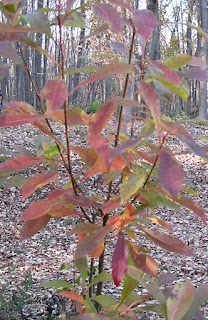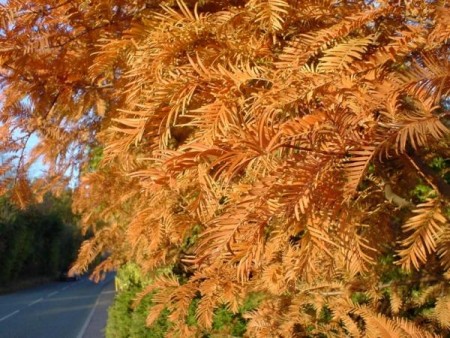

For those of you who like “before and after” pictures, here are two of my Franklinia tree before and after the recent unseasonable snowstorm.
On the left is a flower dripping a little in the rain. On the right is the beautiful maroon foliage that remains – but nary a flower. This little tree, just barely taller than I am, has suffered many setbacks in its young life. Some winters it’s so frost-damaged that I cut it down and start over. This storm only damaged the flowers – possibly the tree is so flexible that it simply bent under the snow.
The Franklinia is a small tree discovered on the banks of the
Another survivor in my garden is the Dawn redwood, a relative of the Coast redwoods of 
And that’s all the good news I can muster. These are hard times for tree huggers, especially here in
Pathologists at the CT Agricultural Experiment Station in
Now, here in
Some of the most beautiful ornamentals, the Okame flowering cherries, suffered the same damage – whole leaders sheared off under the combined weight of foliage and snow.
A contributing factor for much tree damage was the unusual amount of rain our area has gotten in the last two months. Trees can take up a great deal of water during their growing season, and this year, the trees have been very slow to enter dormancy. My sugar maples are usually totally bare by mid-October: this year, those leaves that weren’t blown off by Irene have hung on. The excess water contributed to the unusual weight that branches had to deal with.
Trees with dense canopies, such as beeches; trees with tight-crotched branches, such as elms or cherries; trees with large or heavy leaves, such as magnolias and redbuds – all were candidates for devastation. Shockingly, even famously strong trees like oaks were badly damaged as well.
Irene was painful, but at least it was predictable: hurricanes happen, even in this part of the world. The recent wet snow, however, is an example of nature run amok. Deciduous trees drop their leaves for many reasons; leaf drop clearly has an evolutionary benefit for trees that grow in our climate.
But what happens when the seasons get mixed up? A deciduous tree can’t suddenly rearrange its foliage strategy. Gardeners now face another quandary when selecting plants: not only do we need trees that can withstand winter temperatures of five to ten degrees below zero and prolonged summer heat above 90 degrees, now we must select trees strong enough to hold their leafy branches through heavy, wet snow. (If you shoveled your walk, you know how heavy that stuff was!)
Already, growers are being advised to avoid ash trees because of the Emerald ash borer, maples, birches, and poplars because of Asian long-horned beetles, dogwoods because of Anthracnose, oaks because of Sudden Oak Death, pines because of pine bark beetles – what will be left? Please tell me it isn’t the ironically named Tree of Heaven, also known as Ailanthus.
Perhaps some other trees from the fossil record will turn up – I’ll be waiting.

No comments:
Post a Comment